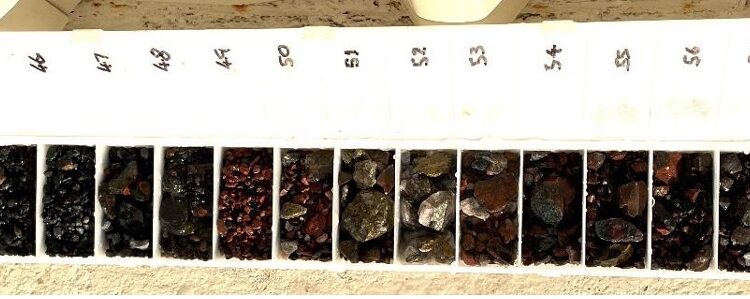Cooper Metals Limited (ASX: CPM) continues to extend mineralisation with the RC drilling programme at King Solomon and Python Cu-Au prospects and the commencement of an induced polarization survey (IP) at the Mt Isa East Copper Gold Project in north-western Queensland, Australia.
RC drilling intersected three separate zones of copper sulphides in drill hole 22MERC055 located in the northern part of King Solomon 1.
Overview of Drilling Programme
A total of 19 reverse circulation holes for 2,816m was completed on a range of targets at King Solomon 1, King Solomon 2, Python and the Camp gossan.
“The November drill programme has been successful in finding new zones of mineralization at King Solomon 1 and 2,” Managing Director Ian Warland said.
“The potential of this new mineralisation will continue to be assessed at depth with IP ahead of any more planned drilling. The first batch of drill samples is in the laboratory on rush, and we expect results in December including the results for the new western zone intersected in hole 22MERC055.
“Now just 12 months on from Cooper listing on the ASX, we have completed over 60 drill holes, many of which have intersected Cu-Au mineralisation, and we have also generated an enviable pipeline of targets thorough the use of VTEM, ground geophysics and geochemistry which we will continue to test through 2023 and beyond. I look forward to updating the market as the new assay results and results of the IP survey come to hand.”
King Solomon 1 Drill Programme Overview
Fifteen drill holes for 1,740m of RC drilling were completed at King Solomon 1 prospect, drilling under historical workings and testing three plunging shoots identified in the August RC drilling programme.
A slightly different approach was taken in this program with most drillholes drilled from the western side towards the northeast. This was designed to explore the footwall zone west of the main mineralised shear zone where drilling in August intersected narrow high-grade gold including 1m @ 0.7% Cu & 1.95g/t Au from 32m (22MERC046).
The drilling has intersected visual sulphides in several holes the most significant visual intersection was in the northern portion of King Solomon 1, where hole 22MERC055 intersected three zones of visual sulphides including a new western zone adjacent to the main mineralised shear zone. The extent of the western zone is unknown
No assay results are available yet. Visual estimates of sulphide mineralisation ranged from trace (<1%), to disseminated (0-10%) and up to semi-massive in one sample (>10%). Sulphide mineralisation is dominantly hosted in sheared siltstones of the Corella Formation and associated with quartz-carbonate alteration. The visible sulphide mineralisation thickness pinches and swells along the King Solomon trend and at this stage the continuity and grade of copper and gold mineralisation is still being assessed.
Visual estimates of sulphide content were completed in the field by a geologist and should not be considered as a proxy or substitute for laboratory analyses. Sulphides contain a mixture of pyrite and chalcopyrite in varying proportions at King Solomon and a mixture of pyrrhotite, pyrite and chalcopyrite at the Python prospect. No visual indication of gold grade can be assessed.
Laboratory assay results are expected in December through to January next year and will be released to the ASX shortly after.
Six hundred and twenty, one metre RC drilling samples (including QA/QC samples) taken from nineteen drill holes, were submitted to Australian Laboratory Services in Mount Isa in two separate batches. The samples will be analysed for a suite of elements including copper and gold. One metre samples were selected by a geologist for laboratory analysis based on the observed geology in the drill chips and guided by a portable XRF machine, where copper was measured at >1000ppm. Samples immediately above and below the mineralised horizon were also selected for analysis.
Python Prospect
Drill hole 22MERC051 testing the Python electromagnetic conductor (EM) intersected pyrrhotite, pyrite and minor graphite. No copper minerals were logged and the portable XRF indicates only low to anomalous levels of copper present. Check assay samples will be submitted to the laboratory for confirmation and to test for gold, possibly associated with the sulphide minerals, however the EM conductor is likely to be explained by the presence of pyrrhotite, pyrite and graphite.
Induced Polarisation Survey
Six lines of IP are planned at King Solomon 1 and the northern part of King Solomon 2 to test for extensions to the mineralisation at depth. The IP is expected to reach 200m plus from surface to help delineate high grade portions of the mineralisation at depth. The IP crew commenced work at site on the 22nd of November and the survey is expected to take around two weeks with results in December.
Next Steps
Obtain assay results for the November drilling and interpret.
Complete IP at King Solomon ahead of any drill planning
For further information please visit: https://www.coopermetals.com.au/












